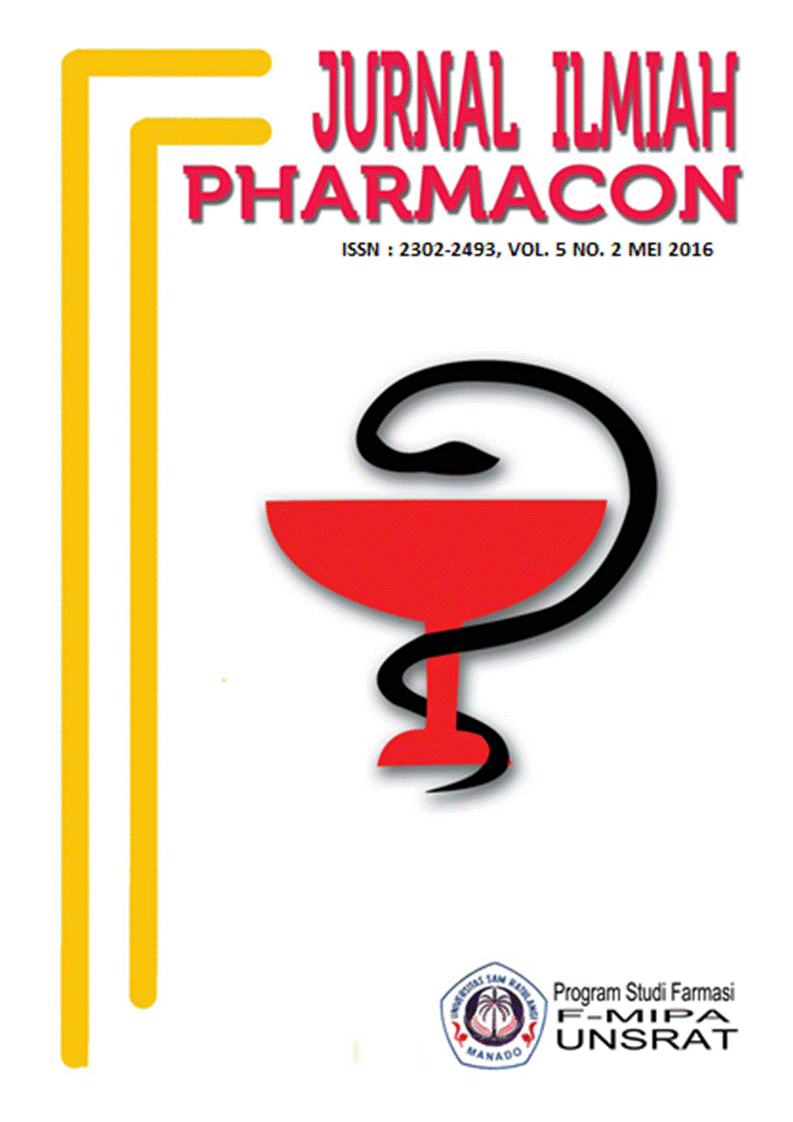UJI KEKUATAN TEKAN PLAT RESIN AKRILIK POLIMERISASI PANAS YANG DIRENDAM DALAM MINUMAN BERKARBONASI
DOI:
https://doi.org/10.35799/pha.5.2016.12185Abstract
UJI KEKUATAN TEKAN PLAT RESIN AKRILIK POLIMERISASI PANAS YANG DIRENDAM DALAM MINUMAN BERKARBONASI
Â
Valentino James Rommy Rawung1), Vonny N. S. Wowor1), Krista Veronica Siagian1)
1) Program Studi Pendidikan Dokter Gigi Fakultas Kedokteran Universitas Sam Ratulangi
Email : docvjrrawung@gmail.com
ABSTRACT
Materials acrylic resin polymerization heat is a material widely used in the manufacture of removable denture base. Currently the polymerization heat by using microwaves (microwave cured) is commonly used in the manufacture of removable denture acrylic. This type of material is widely used because it has aesthetic advantages and relatively low cost, but it also has drawbacks such as easy to crack and can absorb oral fluids. Mouth acidic atmosphere due to the consumption of carbonated beverages can affect the strength of acrylic resin. This study is a pre-experimental design with the static group comparison. Test the strength of acrylic resin plate is immersed in a carbonated beverage using 24 samples of acrylic resin polymerization hot plate with size (25x15x2) mm, consisting of 6 samples at each different soaking time. The results showed that the average compressive strength of acrylic resin plates were soaked for 30 hours amounted to 96.75 MPa, for 60 hours at 81.04 MPa, for 90 hours at 80.83 MPa, and 120 hours at 71, 92 Mpa. Conclusion The study showed a decrease in the compressive strength of the heat polymerization of acrylic resin plate microwave soaked in carbonated beverages in line with the length of time of immersion.
Keywords: Carbonated beverages, the compressive strength.
ABSTRAK
Bahan resin akrilik polimerisasi panas merupakan bahan yang banyak digunakan dalam pembuatan basis gigi tiruan lepasan. Saat ini cara polimerisasi panas dengan menggunakan gelombang mikro (microwave cured) sudah umum digunakan dalam pembuatan gigi tiruan lepasan akrilik. Jenis bahan ini banyak digunakan karena memiliki keuntungan estetik dan biaya yang relatif murah, namun juga memiliki kelemahan antara lain mudah retak dan dapat menyerap cairan mulut. Suasana mulut yang asam akibat konsumsi minuman berkarbonasi dapat memengaruhi kekuatan resin akrilik. Penelitian ini merupakan penelitian pra eksperimental dengan desain the static group comparison. Uji kekuatan plat resin akrilik yang direndam dalam minuman berkarbonasi dengan menggunakan 24 sampel plat resin akrilik polimerisasi panas dengan ukuran (25x15x2) mm, yang terdiri dari 6 sampel pada setiap waktu perendaman yang berbeda. Hasil penelitian menunjukkan bahwa rerata kekuatan tekan plat resin akrilik yang direndam selama 30 jam sebesar 96,75 Mpa, selama 60 jam sebesar 81,04 Mpa, selama 90 jam sebesar 80,83 Mpa, dan selama 120 jam sebesar 71, 92 Mpa. Kesimpulan penelitian menunjukkan terjadinya penurunan kekuatan tekan plat resin akrilik polimerisasi panas gelombang mikro yang direndam dalam minuman berkarbonasi seiring dengan lamanya waktu perendaman.
Kata kunci : Minuman berkarbonasi, kekuatan tekan.
Downloads
Published
How to Cite
Issue
Section
License
Authors who publish with this journal agree to the following terms:
- Authors retain copyright and grant the journal right of first publication with the work simultaneously licensed under a Creative Commons Attribution-NonCommercial 4.0 International License that allows others to share the work with an acknowledgement of the work's authorship and initial publication in this journal.
- Authors are permitted and encouraged to post their work online (e.g., in institutional repositories or on their website) prior to and during the submission process, as it can lead to productive exchanges, as well as earlier and greater citation of published work (See The Effect of Open Access)










